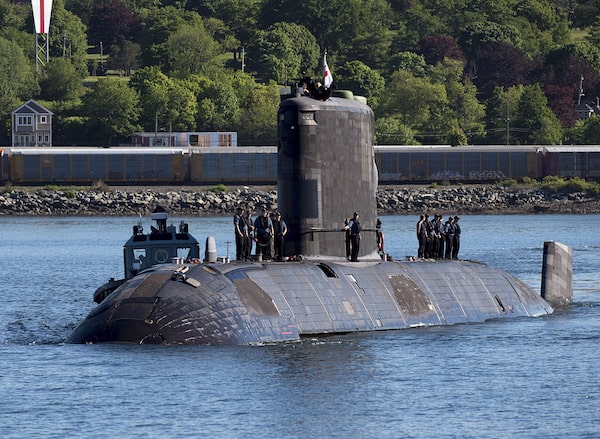
HMCS Windsor, one of Canada's Victoria-class long range patrol submarines, returns to port in Halifax on June 20, 2018.Andrew Vaughan/The Canadian Press
The Canadian government has formally begun looking for up to 12 new submarines, as part of an effort to demonstrate to NATO members that Ottawa is boosting investment in defence in line with its spending commitment to the military alliance.
Defence Minister Bill Blair announced Monday that Canada has issued a request for information so that defence contractors can provide the government with details on “the availability of submarines that are currently in service or in production.”
Prime Minister Justin Trudeau’s government has already ruled out buying nuclear-powered submarines that would have allowed Canada to operate for months underwater, saying it wants to buy less expensive conventionally-powered ships. Such submarines would normally run on a combination of diesel and electric batteries.
Ottawa’s posting online asked for responses from industry by Nov. 18. In a statement, the Department of National Defence said it anticipates a contract award by 2028 and delivery of first submarine “no later than” 2035.
“As an Arctic, Atlantic, and Pacific nation with the world’s longest coastline, Canada needs a new fleet of submarines,” Mr. Blair said in a statement.
“The procurement of up to 12 conventionally-powered, under-ice capable submarines for the Royal Canadian Navy will enhance Canada’s ability to detect and deter maritime threats, control our maritime approaches, and project power and striking capabilities further from our shores.”
The update follows Mr. Trudeau’s announcement at the July meeting of leaders from North Atlantic Treaty Organization member countries in Washington. Canada framed its intention to buy new submarines as part of its plan to raise military spending to the NATO alliance target of 2 per cent of annual economic output. The Canadian government has faced criticism from allies about falling short of this figure.
A draft of the “High Level Mandatory Requirements” that Ottawa seeks in the submarines says the government wants to be able to achieve “initial operating capability” with new submarines by 2037.
It seeks 12 submarines so that three are available at any given time for “continental defence or global deployment” and another three for uses including “national and international exercises.” It requires an additional six to account for the fact that a number of the vessels may be in different stages of maintenance at any given time.
The submarines must be capable of “continuous dived operations” for a minimum of 21 days and able to operate no less than 60 days of self-sustained operation, the draft requirements say.
Ottawa is looking for ships that can perform “precision attacks” including with heavyweight torpedoes, anti-ship missiles and long-range precision land attack missiles.
The ships must be capable of detecting, targeting, engaging and destroying threats, both at sea and ashore, the requirements say.
The list of possible suppliers for new submarines include Thyssenkrupp Marine Systems in Germany, Saab in Sweden, Naval Group in France, Navantia in Spain, Hanwha Ocean and Hyundai in South Korea, as well as Mitsubishi in Japan, according to David Perry, president of the Canadian Global Affairs Institute think tank.
This is one of the only weapons systems where there isn’t a supplier from Canada’s Five Eyes allies such as United States or Britain, he noted.
During the NATO July meeting, the Canadian government cited Russia and China when explaining the need for new subs.
“Competitors are seeking access, transportation routes, natural resources, critical minerals, and energy sources through more frequent and regular presence and activity,” the government said.
“They are exploring Arctic waters and the sea floor, probing our infrastructure and collecting intelligence. In the maritime domain, Russian submarines are probing widely across the Atlantic, Arctic and Pacific Oceans and China is rapidly expanding its underwater fleet.”
Canada currently has four submarines, only one of which is normally operational, bought used from Britain in the 1990s.
Mr. Perry estimated the full cost of acquiring 12 submarines would be up to $120-billion, or $10-billion apiece.
The price of military hardware has a history of rising far beyond what was estimated at the outset, in part because Canadian officials seek to customize their purchases or implement new designs. Mr. Perry, however, said the navy has made it clear it plans to “buy off the shelf or a mature submarine design,” which he said would imply they are not planning to start modifying what can be purchased outright.
He said Canada will have to move quickly to stay on schedule: “If you’re hoping to get an operational submarine by the early 2030s you’ve got to get an RFP [request for proposal] released, hopefully within a year, and a contract signed, in say two or three years with quick delivery after.”
Andrea Charron, director of the Centre for Defence and Security Studies at the University of Manitoba, said Canada has a terrible procurement record when it comes to big weapons platforms.
“But on the other hand, you know, every once in a while, the government surprises us,” she said, noting Ottawa acquired 16 new P-8A surveillance aircraft relatively quickly.